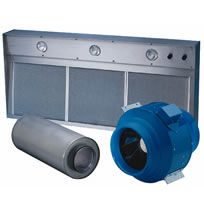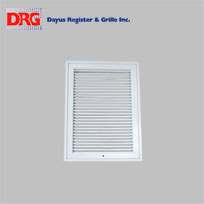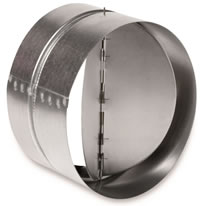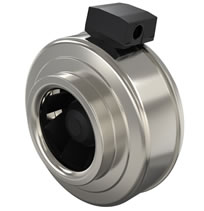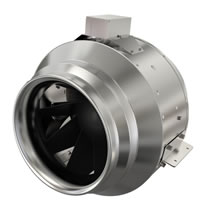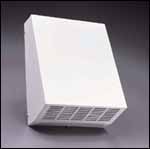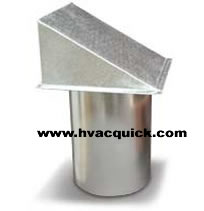|
||||||||||||||||
|
Another less known option that we have provided is a "filter grille" mounted in the ceiling above the cooking area. This inexpensive alternative to a hood is favored by customers with an island stovetop that do not want their view affected. Call us for sizing and details.
How much air? After we have settled on a grille or hood we must calculate how much air flow is required. We usually rely on a number of "rules of thumb". These rules of thumb can sometimes be confusing, and even contradictory, so feel free to call us if you are confused or not sure which one to use. Rule of Thumb 1: Take the hood area (in square feet) and multiply it by 75 to get the CFM (cubic feet per minute) for a wall hood, or multiply it by 100 for an island hood. Rule of Thumb 2: Allow 15 air changes per hour (ACH) for the kitchen. Take the kitchen volume (length x width x height) and divide by 4 to get the required CFM. Rule of Thumb 3: Allow 1 CFM per 100 BTU's per hour (BTUH) heat output. Take the output of the oven and cooktop (if together or close) and divide by 100 to get the required CFM. Rule of Thumb 4: (this applies to commercial type ranges) Allow 100 CFM per linear foot of hood. Take the perimeter of the hood and multiply it by 100 to get the required CFM. Which rule of thumb is the best one to use? The most popular rules of thumb are #1 and #3. We typically use rule of thumb #1 when we size fans. What is next? A backdraft damper, if not supplied with the hood, is highly recommended. This damper (see picture below), keeps outside air from flowing backwards into your house. It should be placed right next to the hood or grille.
Acoustics: Residential kitchen ventilation will require the use of steel or aluminum duct. This type of duct is not very forgiving acoustically and for that reason we recommend using a "silencer" (see picture above). The silencer or duct attenuator can be thought of as a duct version of a car muffler, however the duct silencer will have a low resistance to air flow. The silencer is located between the hood and the fan and can be installed in any orientation (vertical or horizontal). Fans: Fans come in several different configurations. We recommend Fantech fans for most residential applications. All Fantech fans are speed controllable with the use of a "triac" or "solid state" speed controls. In order of popularity here are the most common fans: 1. FKD & FG series in-line fans. In-line fans, as the name implies, are installed in the duct run, typically in the attic. The fan will be equally effective wherever it's placed, however, the quietest position is farthest away from the hood. Range: 135 to 3,000+ CFM.
2. RE series roof or wall mounted fans. This fan series is a low profile roof or wall mounted fan. A typical application for this fan is when the attic is non-existent or inaccessible. Range: 227 to 750 CFM.
3. RVF series wall mounted fans. The RVF fan is ideal for situations that require a wall mounted fan. Range: 124 to 1200 CFM.
Termination Devices: FG and FKD series fans will require either a roof cap or wall hood to terminate the duct and provide a weather tight seal.
The RE and RVF fans do not require roof caps or wall hoods, since they are designed to be weather proof. Some duct and installation tips: - Use high quality aluminum duct tape to seal connections and seams in the duct. - Use Fantech FC clamps to connect in-line fans to duct and/or silencer. - Aluminum, flexible (corrugated) duct that is UL listed for residential kitchen exhaust may be used for short distances (check with your local code official before proceeding). - Use as few elbows and transitions as possible to minimize restrictions to flow. - Shorter is better when it comes to ducting. The longer the duct, the more restriction to flow. - Use ducting that is the same size as your fan (or bigger). For example, if you install an 8" in-line fan, use 8" ducting. Checklist: Here are some resources to help you with your planning: - Our online kitchen builder/configurator - As always, if you would like to ask more questions about this or other technical topics give us a call at 877-711-4822 - 9-5 PST. Live people for technical and sales support - an Internet first! More Links: - Our online kitchen configurator - Kitchen fans - Range hood liners - Silencers and dampers - Speed Controls Disclaimer: Advice and information given through our representatives is checked for usability and conformance with most codes. You as the user, however, have the responsibility for verifying conformance with local codes and standards and ensuring a safe installation. Although HVACQuick.com may employ and use professionals, their advice is not meant as substitute for professional engineering services. It is the customer's responsibility to hire and retain suitable engineering and architectural professionals as required. |
HVACQuick.com
high performance ventilation & green products - large in-stock inventory!
- team@hvacquick.com
- 888-855-7229
